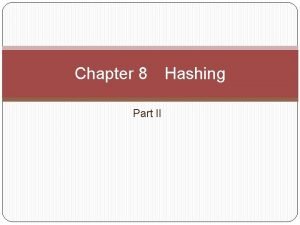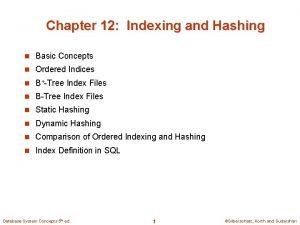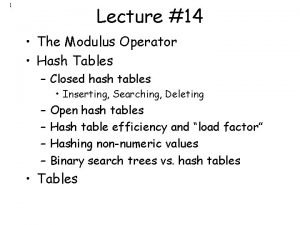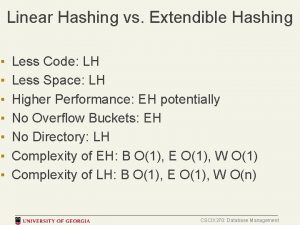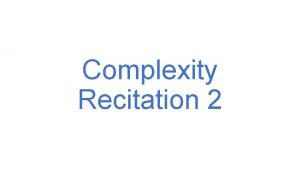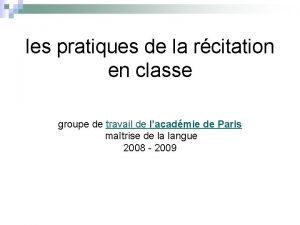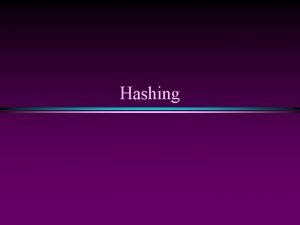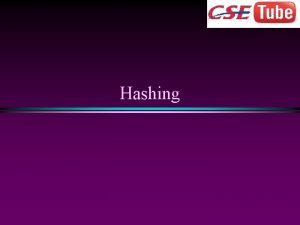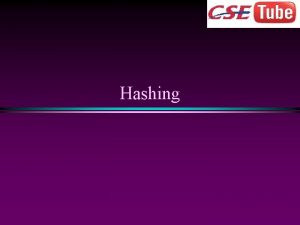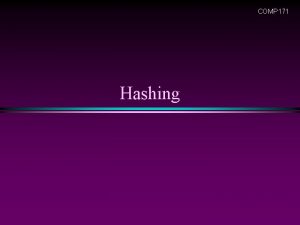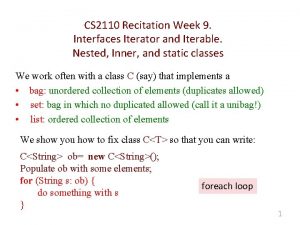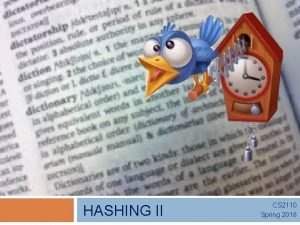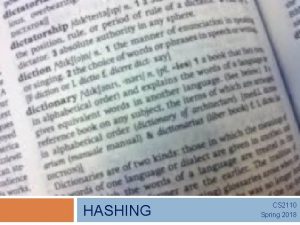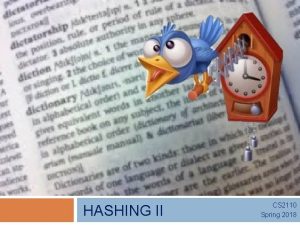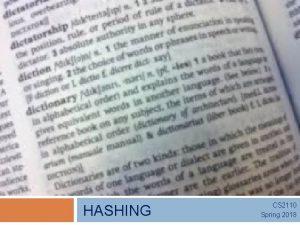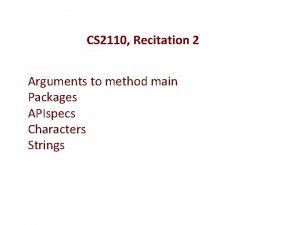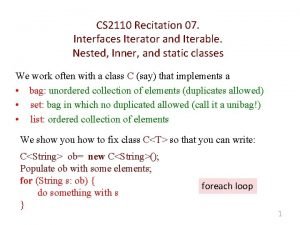CS 2110 Recitation Week 8 Hashing An implementation

![What’s wrong with using an array? Keep set elements in b[0. . n-1] n What’s wrong with using an array? Keep set elements in b[0. . n-1] n](https://slidetodoc.com/presentation_image/08ab9787e7ef44e8abff0b4a069d2482/image-2.jpg)







![/** Rehash array b */ Procedure private void rehash( ) { Hash. Entry[] oldb= /** Rehash array b */ Procedure private void rehash( ) { Hash. Entry[] oldb=](https://slidetodoc.com/presentation_image/08ab9787e7ef44e8abff0b4a069d2482/image-10.jpg)

![Quadratic probing b[k] b[k+12] b[k+22] b[k+32] … Someone proved: If 1. Size of array Quadratic probing b[k] b[k+12] b[k+22] b[k+32] … Someone proved: If 1. Size of array](https://slidetodoc.com/presentation_image/08ab9787e7ef44e8abff0b4a069d2482/image-12.jpg)






- Slides: 18

CS 2110 Recitation Week 8. Hashing: An implementation of a set. It provides O(1) expected time for set operations Set operations • Make the set empty • Add an element to the set • Remove an element from the set • Get the size of the set (number of elements in it) • Tell whether a value is in the set • Tell whether the set is empty. Note: We work here with a set of Strings. But the elements of the set could be anything at all; only the “hash function” would change. 1
![Whats wrong with using an array Keep set elements in b0 n1 n What’s wrong with using an array? Keep set elements in b[0. . n-1] n](https://slidetodoc.com/presentation_image/08ab9787e7ef44e8abff0b4a069d2482/image-2.jpg)
What’s wrong with using an array? Keep set elements in b[0. . n-1] n 4 []@78 b []@78 • Adding an element requires testing whether it is in the array. Expected time O(n) • Removing an element requires moving elements down. Expected time O(n) • Testing whether an element is in: expected time O(n) 0 1 2 3 "xy" "abc" "1$2" "aaa" … … … Keeping the array sorted presents its own problems. Array. List and Vector implemented using arrays; same problems 2

Solution: Let an element appear anywhere in b Keep set elements anywhere in b []@xy A hash function says where to put an element In example to right: "abc" hashes to 0 "1$2" hashes to 100 "235" and "aaa" both hash to 60 Collision: string hashes to occupied place Solution: Put in next available space 0 "abc" 60 61 "235" "aaa" 100 "1$2" 999 "xy" 3

Array elements: null or of type Hash. Entry /** An instance is an element in hash array */ private static class Hash. Entry { public String element; // the element public boolean is. In. Set; // = "element is in set" } /** Constructor: an element that is in the set iff b */ public Hash. Entry( String e, boolean b) { element= e; is. In. Set= b; } Hash. Entry object says whether it is in set. To remove an element, set field is. In. Set to false. 4

Hashing with linear probing To add string "bc" to set: int k= hash. Code("bc"); We discuss hash functions later 0 k b … Check elements b[k], b[k+1], … until: null or element containing "bc" is found Probe: checking one element 5

Basic fact int k= hash. Code(s); 0 k b … Suppose k = hash. Code(s). Suppose s is in set. Let b[j] be first (with wraparound) null element at or after b[k]. Then s is in one of elements b[k. . j-1] (with wraparound) Basic fact relies on never setting an element to null 6

/** Add s to this set (if not in) */ procedure add public void add(String s) { int k= hash. Code(s); while (b[k] != null && !b[k]. element. equals(s)) k= (k+1) % b. length(); % (remainder) if (b[k] = = null) { gives wraparound b[k]= new Hash. Entry(s, true); size= size+1; return; } // s is in b[k] –but it may not be in the set if (!b[k]. is. In. Set) { b[k]. is. In. Set= true; size= size + 1; } } 7

procedure remove /** Remove from this set (if it is in) */ public void remove(String s) { int k= hash. Code(s); while (b[k] != null && !b[k]. element. equals(s)) k= (k+1) % b. length(); if (b[k] = = null || !b[k]. is. In. Set) { return; // s is in b[k] and is in the set; remove it b[k]. is. In. Set= false; size= size - 1; } 8

Load factor lf = (number of elements that are not null) / b. length Estimate of how full array is: close to 0: relatively empty Close to 1: too full Somebody proved: Under certain independence assumptions (about the hash function), the average number of probes in adding an element is 1 / (1 – lf) Array half full? Addition expected to need only 2 probes! E. g. size 2000, 1000 elements are null. Only 2 probes! Wow! 9
![Rehash array b Procedure private void rehash Hash Entry oldb /** Rehash array b */ Procedure private void rehash( ) { Hash. Entry[] oldb=](https://slidetodoc.com/presentation_image/08ab9787e7ef44e8abff0b4a069d2482/image-10.jpg)
/** Rehash array b */ Procedure private void rehash( ) { Hash. Entry[] oldb= b; // copy of array b // Create a new, empty array b= new Hash. Entry[next. Prime(4 * size)]; size= 0; rehash // Copy active elements from oldb to b for (int i= 0; i != oldb. length; i= i+1) if (oldb[i] !== null && oldb[i]. is. In. Set) b. add(oldb[i]. element); } Size of new array: first prime larger than 4 * (size of set) Why a prime? Next slides 10

Quadratic probing Linear probing: Look at k, k+1, k+2 … Clustering: because 2 strings that hash to k, k+1 have almost same probe sequence Instead, use quadratic probing: Removes primary clustering b[k] b[k+12] Efficient calculation: b[k+22] (i+1)2 – i 2 b[k+32] = <arithmetic> 2*i – 1 … Get to next probe with mult and add 11
![Quadratic probing bk bk12 bk22 bk32 Someone proved If 1 Size of array Quadratic probing b[k] b[k+12] b[k+22] b[k+32] … Someone proved: If 1. Size of array](https://slidetodoc.com/presentation_image/08ab9787e7ef44e8abff0b4a069d2482/image-12.jpg)
Quadratic probing b[k] b[k+12] b[k+22] b[k+32] … Someone proved: If 1. Size of array is a prime 2. Load factor <= 1/2 Then • A new element can be added • Probe sequence never probes same elements twice Two facts hold for linear probing even if size is not prime. But quadratic probing requires prime size 12

Hash function Want a hash function that doesn’t put too many elements at the same position. Class String has a good hash function s. hash. Code() The specs define it as (with n the length of s): s[0]*31 n-1 + s[1]*31 n-1 +. . . + s[n-1] Time is O(n)! Extremely long strings? Create you own hash function, But it’s not easy to create a good one. 13

Java’s hashcode-equals contract Hash. Code and equals are implemented in class Object. Hash. Code in Object: usually implemented by converting internal address (pointer) to an integer General contract for Hash. Code: • During an execution, c. hash. Code() should consistently return same value unless info used in calculating c. equals(…) is changed • c 1. equals(c 2) true? Then c 1. hash. Code() = c 2. hash. Code() • c 1. equls(c 2) false? For best performance c 1. hash. Code() != c 2. hash. Code() —but not required. Override equals? Then override hash. Code also if you are going to use it. 14

Summary We presented basics of hashing, although there a few other ideas you should be aware of. We summarize, giving references to the text by Carrano and elsewhere for more information. Carrano does Hashing in Chapter 21, 523– 546. Describe basic idea of hashing (524– 526). • hash table (the array) • hash function: Given search key, compute a hash code: an integer. Integer is then changed (Carrano says compressed) to be in range of hash table, usually using remainder function. • Perfect hash function: maps each search key into a different integer that is an index in the hash table. • Good hash function properties: (1) minimize collisions, (2) Be fast to compute. 15

Summary Java hash functions: String provides hash. Code function. It’s >= 0. Each wrapper class provides hash. Code function for the values that it wraps; for class Integer, it is the wrapped int, so it can be negative. (page 528– 530). Cryptographic hash function (visit Wikipedia). Produce a fixed -size bit string for an arbitrary block of data such that any change to the data will, with high probability, change the hash value. Critical for information security applications, like digital signatures. Not easy to come up with good ones. The widely used MD 5 Message-Digest Algorithm (by Ron Rivest of MIT) produces a 16 -byte hash value, but it has flaws. 16

Summary Hash table size n: Best n is a prime > 2. Then compression of hash code using % n provides indices that are distributed uniformly in 0. . n-1 (page 531). Be careful with h % n: it not the modulus operation. If h < 0, h% n is in 1 -n. . 0, so add n or use absolute value. Load factor lf: Ratio of number of occupied hash-table elements to size of hash-table. Proved: for linear or quadratic probing, under certain independence conditions, the average number of probes in adding an element is at most 1 / (1 – lf). So if hash table is half full, only 2 probes expected! Keep it at most half full by making bigger hash table when necessary. 17

Summary Collision: Occurs when two different search keys hash and are then compressed to same index. Two general ways to proceed: 1. Open addressing: Use • Linear probing. Has problem of primary clustering • Quadratic probing. Hash table size should be a prime • With both linear and quadratic probing, don’t remove a deleted element from hash table. It must stay there with a flag indicating it is not in set. 2. Separate chaining: Entry in hash table is head of a linked list of all keys that hash to same index. Takes more space but eliminates many collisions (page 539– 542). 18
 What is static hashing in dbms
What is static hashing in dbms Static and dynamic hashing in dbms
Static and dynamic hashing in dbms What does a modulo operator do
What does a modulo operator do Distinguish between extendible and linear hashing
Distinguish between extendible and linear hashing What is meant by etiquette of recitation of the holy quran
What is meant by etiquette of recitation of the holy quran Rote recitation of a written message
Rote recitation of a written message Recitation les machines
Recitation les machines Learning objectives of poem recitation
Learning objectives of poem recitation Process oriented learning competencies example
Process oriented learning competencies example Passive recitation
Passive recitation Know your material
Know your material Récitation les hiboux
Récitation les hiboux Namaz posture 1
Namaz posture 1 Week by week plans for documenting children's development
Week by week plans for documenting children's development Millog tervola
Millog tervola Raisecom wifi
Raisecom wifi čos 051672
čos 051672 Aqap
Aqap Rotary distretto 2110 organigramma
Rotary distretto 2110 organigramma
